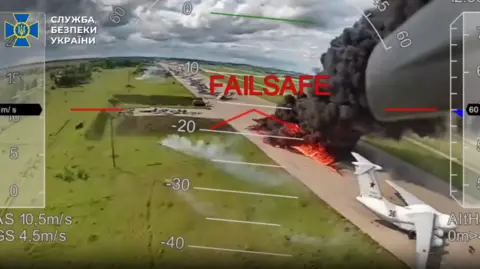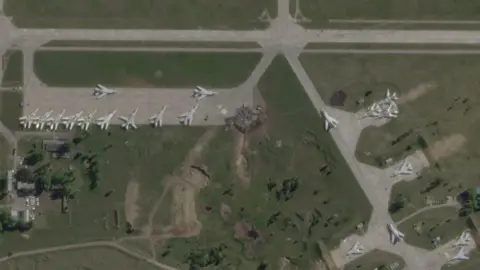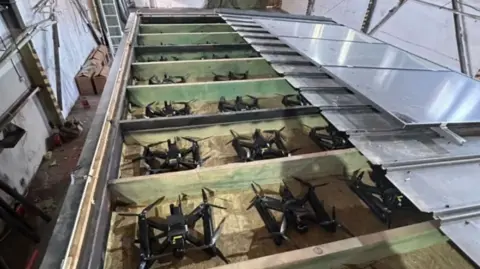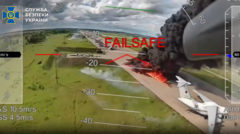Paul Adams
Diplomatic correspondent
Reporting fromKyiv, Ukraine

 SBU
SBU
Three days on, and Ukraine is still digesting the full implications of Operation Spider’s Web, Sunday’s massive assault on Russia’s strategic aviation.
On Wednesday, the agency which orchestrated the attack, the Security Service of Ukraine (SBU), released additional, vivid footage of the attacks in progress, as well as tantalising glimpses into how the whole complex operation was conducted.
Satellite images that have emerged since Sunday, showing the wrecked outlines of planes sitting on the tarmac at the Olenya, Ivanovo, Dyagilevo and Belaya airbases, also help tell the story of the operation’s unprecedented success.
For Ukrainian observers, the whole operation, a year-and-a -half in the making, remains a marvel.
“This can be considered one of the most brilliant operations in our history,” Roman Pohorlyi, founder of the DeepState, a group of Ukrainian military analysts, told me.
“We’ve shown that we can be strong, we can be creative and we can destroy our enemies no matter how far away they are.”
It’s important to note that almost all the information that has emerged since Sunday has been released by the SBU itself.
Flushed with its own success, it is keen to cast the operation in the best possible light. Its information campaign has been helped by the fact that the Kremlin has said almost nothing.
Speaking to the media on Wednesday after handing out medals to SBU officers involved in the operation, the Ukrainian president, Volodymyr Zelensky repeated the claim that 41 aircraft had been damaged or destroyed.
“Half of them cannot be restored,” he said, “and some will take years to repair, if they can be restored at all.”
Had a ceasefire been in place, he added, Operation Spider’s Web would not have happened.
The latest four-minute compilation released by the SBU shows a number of key details.
Shot from the perspective of some of the 117 drones involved, we see Russian strategic bombers, transport aircraft and airborne warning and control (AWACS) being hunted down.
Fires can be seen raging on a number of stricken planes.
For the first time, we get glimpses under the wings of some of the bombers, revealing that they were already armed with cruise missiles, which Russia has used to devastating effect in its air raids on Ukraine.
The drones, many flown remotely by a separate pilot, sitting far away in Ukraine, are carefully and precisely aimed at vulnerable points, including fuel tanks located in the wings.
Some of the resulting fireballs also suggest the tanks were full of fuel, ready for take off.

 PLANET LABS/REUTERS
PLANET LABS/REUTERS
One significant section of the video shows drones homing in on two Beriev A-50s, giant AWACS aircraft first produced in the Soviet Union.
Of all the aircraft targeted by Operation Spider’s Web, the A-50, with its radar capable of seeing targets and threats more than 600km (372 miles) away, is arguably the most important.
Before the full-scale invasion in 2022, Russia was thought to operate around nine A-50s. Before last Sunday, as many as three had been shot down or damaged in an earlier drone attack.
The latest footage strongly implies that drones hit the circular radar domes of the two A-50s parked at the Ivanovo Severny airbase, north-east of Moscow.
However, since the video feed cuts out at the moment of impact, this is hard to completely verify.
Satellite imagery, which clearly displays the wreckage of numerous bombers, is inconclusive when it comes to the A-50.
But Russia’s fleet of these crucial aircraft could now be down to as few as four.
“Restarting production of the A-50 is presently highly unlikely, due to difficulties with import substitution and the destruction of production facilities,” defence analyst Serhii Kuzan told me.
“As such, every loss of this type of aircraft constitutes a strategic problem for Russia, one it cannot quickly compensate for.”

 Getty Images
Getty Images
Earlier on Wednesday, the SBU offered a brief glimpse into another of Sunday’s remarkable features: the use of specially constructed containers, mounted on flatbed trucks, to transport armed drones to sites close to the four Russian airbases.
Two videos show a truck carrying what appear to be two wooden mobile homes, complete with windows and doors.
In one video, roof panels are clearly visible. Reports suggest these were retracted or otherwise removed shortly before the attacks began, allowing dozens of drones stored inside to take off.
It’s not known when or where the videos were filmed, although snow visible beside the road in one suggests it could have been weeks or months ago.
In another video, posted on a Russian Telegram channel on Sunday, a police officer was seen entering the back of one of the containers in the wake of the attack.
Seconds later, the container exploded, suggesting it may have been booby-trapped.

 SBU
SBU
How to assess the impact of such a spectacular operation?
“From a military point of view, this is a turning point in the war,” aviation expert Anatolii Khrapchynskyi told me.
“Because we have dealt a significant blow to Russia’s image and the capabilities of the Russian Federation.”
A little over three months after Donald Trump berated Volodymyr Zelensky, telling him he had “no cards,” Ukraine has offered an emphatic riposte.
“Ukraine has shown the whole world that Russia is actually weak and cannot defend itself internally,” Khrapchynskyi said.
But that doesn’t mean that Russia is about to change course.
After his latest conversation with Vladimir Putin, Donald Trump said the two leaders had discussed Ukraine’s attacks.
“It was a good conversation,” President Trump posted on Truth Social, “but not a conversation that will lead to immediate Peace.”
“President Putin did say, and very strongly, that he will have to respond to the recent attack on the airfields.”







